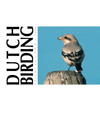Dutch Birding volume 30 (2008) no 4

30 years Dutch Birding, part 4: 1994-98
This paper describes the fourth five-year period of Dutch Birding and the DBA. This period was characterized by a broadening of activities, some directly stimulated by the DBA but others also as 'spin-off'. The rapid growth of the number of subscribers came to an end, partly because new journals (such as Alula and Ornithos) were started in other countries, making it more difficult to attract new foreign subscribers. Many new ideas and activities were launched but also choices had to be made because the resources were limited and the production costs of six full-colour issues of Dutch Birding per year were considerable. Thanks to the well-operated birdline, a growing number of pager groups (five groups by the end of 1998) and the first steps on the internet, the information and communication infrastructure was strongly boosted and this resulted in an increase of field activities by a growing number of competent and competitive birders. As a result, this period now stands as one of the most productive in the history of the DBA, with 16 new species added to the Dutch list, some of them of outstanding rarity quality - and most were twitchable! Also, many former rarities were found on a more regular basis and became 'available' for most birders. Important milestones in this period were the publication of the second stage of the revision of the Dutch list by the Dutch rarities committee (CDNA) and the revival of the Dutch committee for avian systematics (CSNA). The latter took a leading role in drawing conclusions and making taxonomic decisions based upon a stream of new publications on taxonomic relationships induced by, eg, modern research on DNA and vocalisations. For birders, the upsurge in the number of 'splits' was the most striking outcome of this work. Almost all of these decisions were later followed by other taxonomic committees. As a result of these splits combined with the large number of twitchable rarities in 1994-98, the first Dutch birders crossed the 400-species mark and, in late 1998, the number one twitcher, Klaas Eigenhuis, had recorded a total of 427 species. Another milestone was the preparation of part 1 of the new avifauna book for the Netherlands, dealing with rare birds, which appeared just after this period in spring 1999.
New species were (in chronological order): House Crow Corvus splendens, Steppe Grey Shrike Lanius pallidirostris and Lesser Scaup Aythya affinis in 1994; Greater Yellowlegs Tringa melanoleuca, Daurian Jackdaw Corvus dauuricus, Daurian Shrike L isabellinus, Bulwer's Petrel Bulweria bulwerii (still causing debate) and Upland Sandpiper Bartramia longicauda in 1995; White-throated Needletail Hirundapus caudacutus, Myrtle Warbler Dendroica coronata and Isabelline Wheatear Oenanthe isabellina in 1996; Hutchins's Cackling Goose Branta hutchinsii hutchinsii, Pied-billed Grebe Podylimbus podiceps, Spanish Sparrow Passer hispaniolensis and Oriental Pratincole Glareola maldivarum in 1997; and Stilt Sandpiper Calidris himantopus in 1998.
Other notable records were, eg, Great Spotted Cuckoo Clamator glandarius (first twitchable), Rufous-tailed Rock Thrush Monticola saxatilis (second, first twitchable), Cretzschmar's Bunting Emberiza caesia (second, not twitched because of miscommunication during its five-day stay), White-rumped Sandpiper C fuscicollis (first twitchable), Asian Desert Warbler Sylvia nana (second) and several Pine Buntings E leucocephalos (first twitchable) in 1994; Red-headed Bunting E bruniceps (first twitchable), White-throated Robin Irania gutturalis (second), Bonelli's Eagle Aquila fasciata (second, first twitchable) and Dartford Warbler S undata (first twitchable) in 1995; Black-throated Thrush Turdus atrogularis (first twitchable), Steller's Eider Polysticta stelleri, Eastern Black-eared Wheatear O melanoleuca (first twitchable), Blyth's Reed Warbler Acrocephalus dumetorum (second, first twitchable), Semipalmated Sandpiper C pusilla (second), Red-necked Stint C ruficollis (second), Two-barred Warbler Phylloscopus plumbeitarsus (second), Red-eyed Vireo Vireo olivaceus (first twitchable), Blyth's Pipit Anthus godlewskii (second, first twitchable) and another Daurian Shrike in 1996; Ivory Gull Pagophila eburnea (third, not twitchable), Laughing Gull Larus atricilla (second, first twitchable) and Whistling Swan Cygnus columbianus (first twitchable) in 1997; and another Pied-billed Grebe, White-tailed Lapwing Vanellus leucurus (first twitchable), white-morph Gyr Falcon Falco rusticolus, Black-winged Kite Elanus caeruleus (second, first twitchable), another Black-throated Thrush, Eurasian Scops Owl Otus scops (first twitchable), Blue-cheeked Bee-eater Merops persicus (second, not twitchable), another Red-necked Stint and two Sharp-tailed Sandpipers C acuminata (second and third) in 1998. The big day record was set at 172 in 1996 and the year record at c 330 in 1998.
G J (Hans) ter Haar, Hollandse Hout 127, 8244 GD Lelystad, Nederland
(hterhaar planet.nl)
planet.nl)
terug






